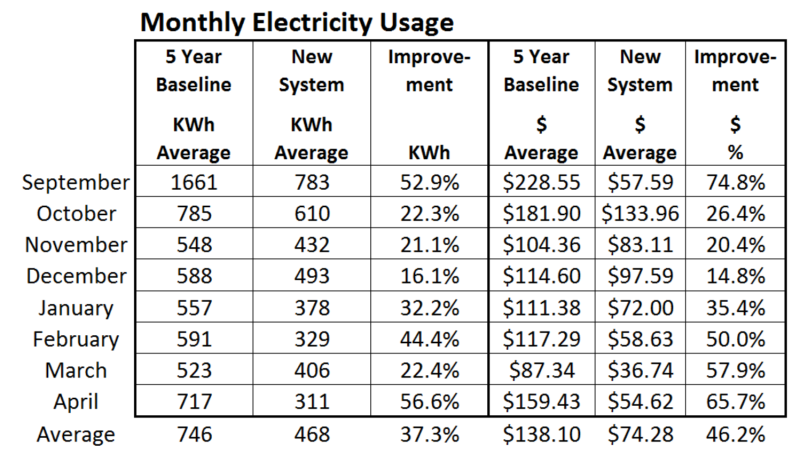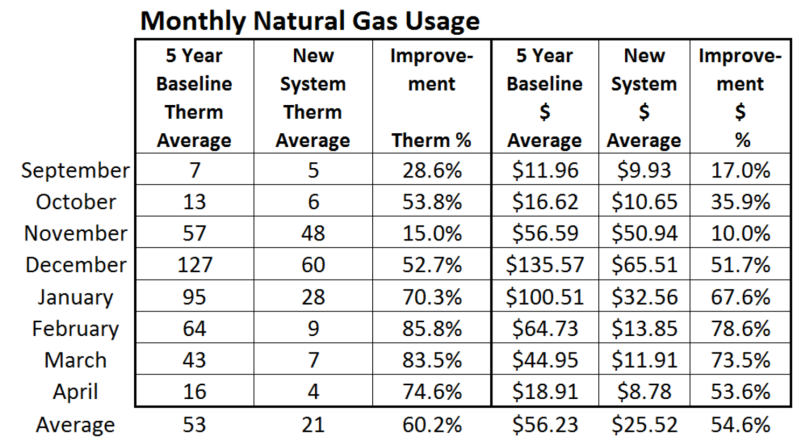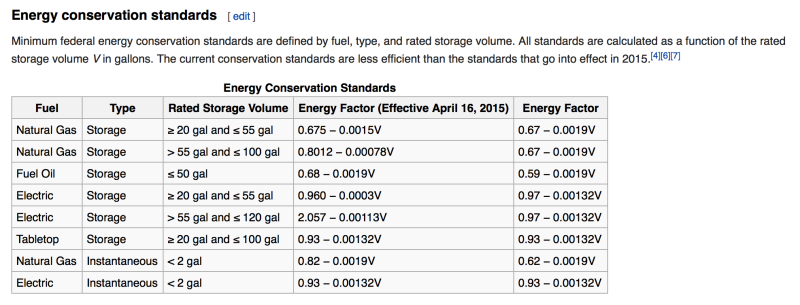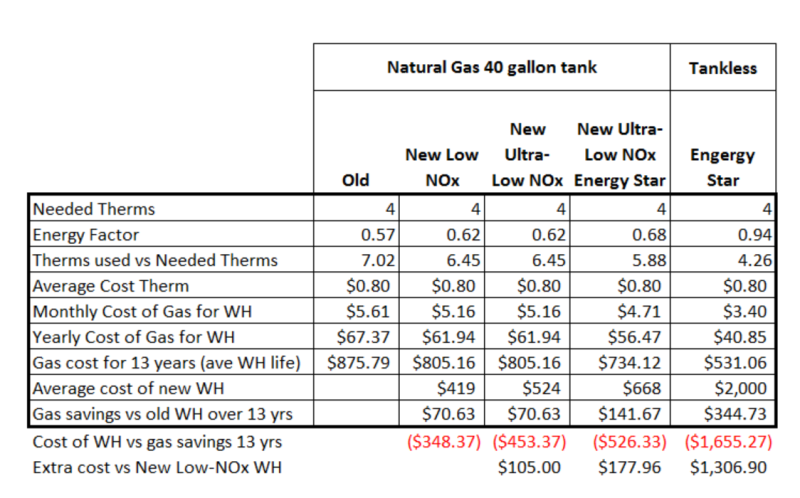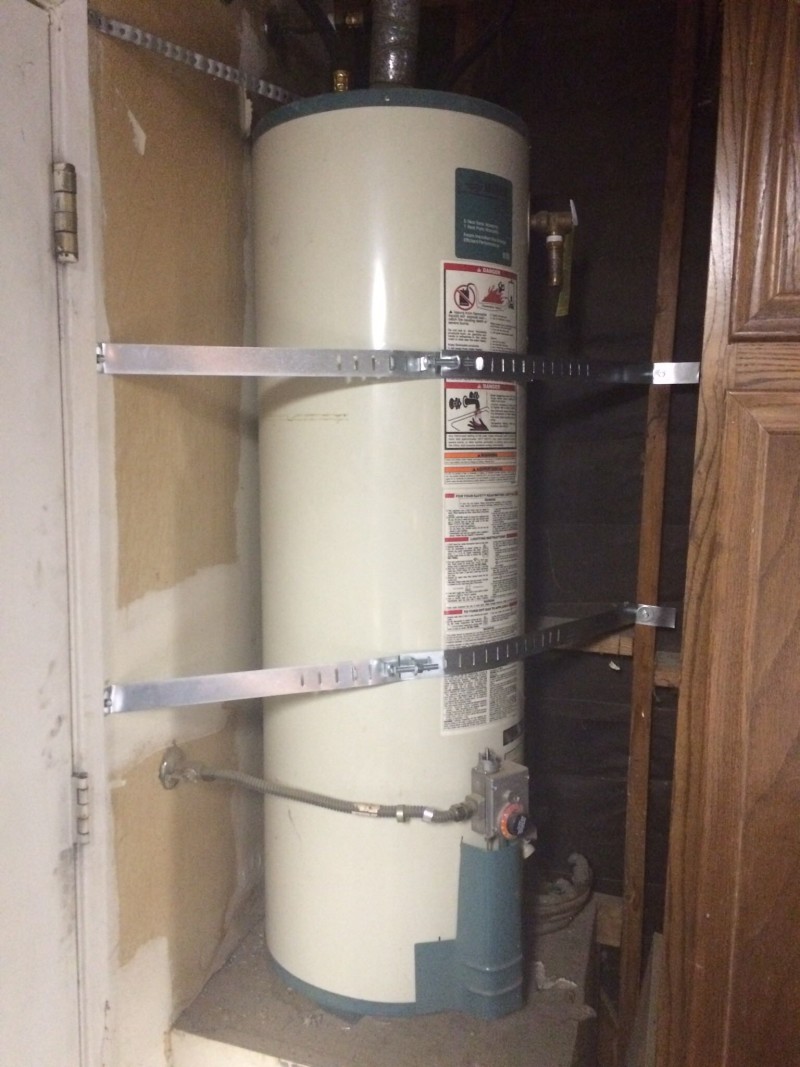In January I wrote that home solar might be lipstick on a pig, and it makes more sense to make a home energy efficient before even considering solar. I also promised to post monthly updates on our utility bills.
One thing I did towards the end of the month was install a new water heater. If you are interested in what I found from my research, you can read the nightmarish details after the charts.
As planned, electricity use is declining versus the 5 year baseline as the as the average temperature increases. Improved insulation and a more efficient air conditioner are using much less energy. For April our electricity use is down 56.6% versus the 5 year April baseline WITHOUT a solar system.
NEW WATER HEATER
Our old water heater was over 20 years old and it was just a matter of time before it died. My research revealed that the average water heater has a useful life of 13 years. I also discovered that a water heater should be flushed about once a year to prevent sediment from collecting at the bottom of the tank – who would have known? This is why water heaters come with a manual and we should read them. I suspected we might have some sediment because the water heater sometimes acts funny. More on that later. One might wonder if sediment on the bottom of a tank will cause the water heater to use less natural gas, since it would have less water in it; or does sediment cause a water heater to be less efficient. I don’t know.
Energy Factor (or EF)
Right off the bat, I discovered that water heaters are rated using something called an “Energy Factor.” No matter what the efficiency might be, I knew I wanted another natural gas heater, as the cost to purchase natural gas is exponentially cheaper than electricity. So off I went to Google to learn what would be the best choice for me, and there I immediately found my new nemesis, Energy Factor, and a difficult thing to figure out.
Wikipedia told me there is a standardize Government test to determine the efficiency of a water heater. Wow, the government is involved? Here’s the formula:
What the hell?
Then Wikipedia told me that the Government has requirements for efficiency, which is nobody can manufacture a water heater unless it meets minimum Government Mandated standards. No surprise, the Government wants to control every aspect of our lives.
The Government has a formula and Wikipedia was courteous enough to furnish this table:
Okay, but I still didn’t know what the Energy Factor really was, as it has been almost 50 years since I took calculus and I forgot how to figure out the formula. On to more research…
I found the Federal Government has a website, ww.energy.gov, to educate us. More government wasted taxpayer money. Here is what it says…
And it has a calculator explanation…
And a worksheet to help us stupid citizens…
Okay, here’s the bottom line. Our old water heater had an Energy Factor of 0.57. This means that as a quick, but not exact, explanation reveals that 57% of the energy consumed actually heats the water, the rest goes up the vent or is dissipated while the hot water just sits in the water heater waiting for someone to take a shower, wash laundry or dishes.
Our camper has a 6 gallon water heater and it works just fine. Our old house water heater had a 30 gallon capacity. Joyce wanted a 40 gallon replacement. Why? Well, that’s what she wants and nothing else really matters. The Federal Government requires a 40 gallon water heater to have an Energy Factor of 0.62, which is 5 points higher than our old water heater. Well the Fed’s sort of want a EF of 0.62, they actually want a EF of 67.5 minus 0.0015 times each gallon of water volume (V), which would be
EF = 0.675 – (0.015 * V)
A water heater with the Government Energy Star Certification would need to be 0.68 Energy Factor. If you don’t truly know what an Energy Star Rating is, well you might as well shoot yourself in the head with a .38 revolver, because all things Government are out of control. Anyway, for the water heater search, so far, so good for what I needed to know.
California Emissions Standards
Then I found out I must buy a water heater that meets the People’s State of California standards for low emissions of oxides of nitrogen (NOx). To meet these standards, these tend to be less efficient, so more expensive to meet both the EF Rating and the California NOx requirement. These are called “Low NOx water heaters. Sigh.
So I went back to the computer and a search on the Home Depot website for prices and availability. Every inexpensive water heater that supposedly was in stock showed that it was not available in any of the Home Depot stores in the Coachella Valley where we live. I was looking at the cheapest Rheem model. However, the Home Depot in Yucca Valley, 26 miles away, had 9 of them in stock.
SCAQMD
Here’s the deal… we live in Riverside County, and there is ANOTHER regulatory government agency, the South Coast Air Quality Management District, which has imposed even stricter NOx emission water heater requirements for most of Southern California and as far north as San Francisco!! However, Yucca Valley, only 26 miles ways is not subject to this regulation. Double sigh.
“WAIT, WE’LL DOUBLE YOUR ORDER!”
You know the informercials, we’ll double your order for just $19.99 plus shipping and handling. Now I was in double your pain; double your taxes shock instead of a good deal.
Jesus H. Christ! All I want is a friggin’ inexpensive water heater I can quickly and conveniently purchase, and install it myself. You know, you go to the hardware store and tell the salesperson you want a natural gas water heater. He asks, “What size.” You tell him and he shows you what he has. Anyway, at this point — in a time-sucking, brain-twisted, state of shock, you can figure out what I did.
Business Case
On average, our old water heater used about 7 therms of gas per month. Using the EF of 0.57, means that we need 4 therms of water heater per month and we were “wasting” 3 therms per month. We pay about 80 cents per therm (it changes depending on the time of year).
So, I built a spreadsheet for comparison purposes…
As you can see from the table above, there is no ROI on the more expensive options. I could buy a tankless for $1,300, but the required extra materials to install it brings the cost to around $2,000, which is considerably less than the $3,600 our Energy Audit Company quoted us. Everything I read about tankless water heaters included lower cost of operation and reduced emissions. But nowhere did I actually find numbers put together like the chart above. BUYER BEWARE!!
Installation
Government Regulations (e.g., building codes) require that a natural gas water heater installed in an attached garage be elevated at least 18” above ground, as was our old heater in the picture below.
Our new water heater installation manual states that our heater is a Flammable Vapor Ignition Resistant (FVIR Certified) Water Heater and
… can be installed on a residential garage floor without the use of an 18-inch stand in accordance with National Fuel Gas Code, NFPA 54, ANSI Z223.1, unless otherwise directed by State and Local code requirements.
Awesome! By the way, a water heater weighs around 125 lbs, and I wouldn’t have been able to lift the new one up by myself. I figured I could get the old one down and then dismantle the 24” shelf.
Opps…
Remember I mentioned sediment? Well, the old water heater was full of sediment at the bottom of the tank and after several ingenious attempts to open the drain; I could not drain the water. Now I had a 400 lb monster (125 lb water heater and approximately 30 gallons of water at 8.33 lbs per gallon), and no way could I or even two people lift it. So… with a carefully calculated and measured angles of fall, I pulled the water heater off the shelf to its death with a rope, and no cabinets or other garage-bound storage items were injured.

New Water Heater Installed
Still need to do some trim work and wall repairs.
